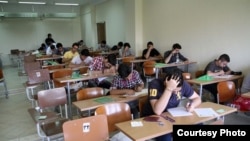In a country that calls itself a pioneer against illiteracy in the region, a huge proportion of children in Iran leave school before receiving their high-school diploma.
Fifty-three percent of dropouts are due to financial difficulties that families are facing, announced Ali Bagherzadeh, head of Iran's Literacy Movement Organization, on July 24.
Bagherzadeh did not specify what this percentage means in actual numbers, but Radio Farda recently quoted child activists saying more than 3 million of Iranian children, meaning a quarter of the total number of students in primary and secondary education, never finished school.
Iranian newspaper Donya-e Eqtesad even concluded a few years ago that one-third of Iranians between the ages of 6 and 18 were deprived of education.
According to experts, many of these children end up in child labor. Based on unofficial estimates, there are between 2 million and 7 million child workers in Iran who are not only deprived of a normal childhood experience but also exposed to violence and other types of abuse.
The figures become even more significant in light of Supreme Leader Ayatollah Ali Khamenei’s recent harsh attacks against the government of President Hassan Rouhani for adopting the UNESCO 2030 educational document that, among other things, encourages signatories to ensure free quality primary and secondary education for all girls and boys. Khamenei bashed the UN document for being “anti-Islamic” and “immoral,” and forced Rouhani’s government to denounce it.
Considering the fact that modern education in Iran has a 180-year history, and the law for compulsory education for children is a century old, such a high number of children deprived of education in the country means a “big national and social defeat for the government and society,” wrote Said Peyvandi, an Iranian sociologist living in France, in an analysis for Radio Farda.
“After more than a century, the Iranian government had not been able to reach one of its primary goals in education,” Peyvandi added. Besides family poverty, a lack of sufficient educational facilities in remote and rural areas and a lack of awareness among traditional families were the main factors responsible for the crisis, he said.
The latter factor affects mostly girls.
Even though nowadays the majority of Iranian college students are female, there are still parents in Iran who do not value female education. They are likely to force their daughters to marry as minors.
Without further elaborating, Bagherzadeh said about 35 percent of school dropouts in the country happened because of “cultural issues.”






